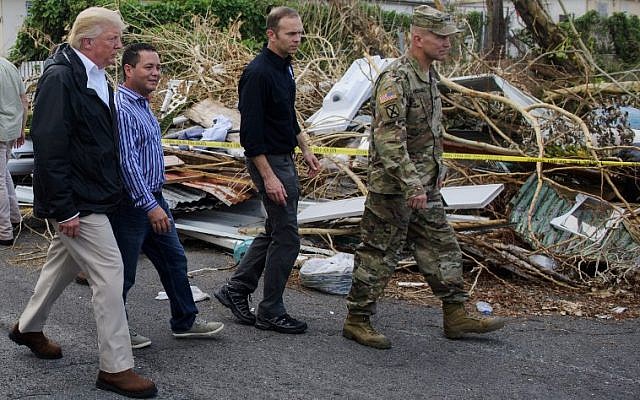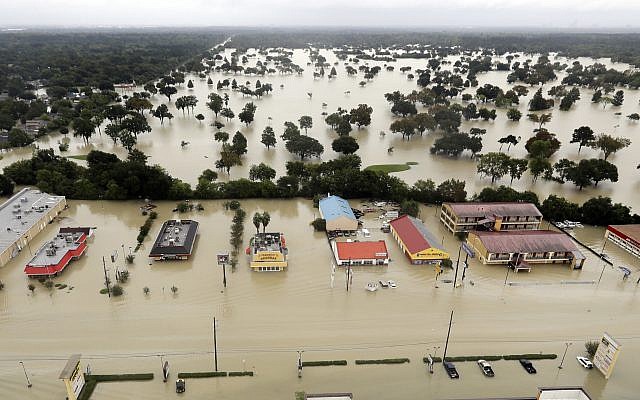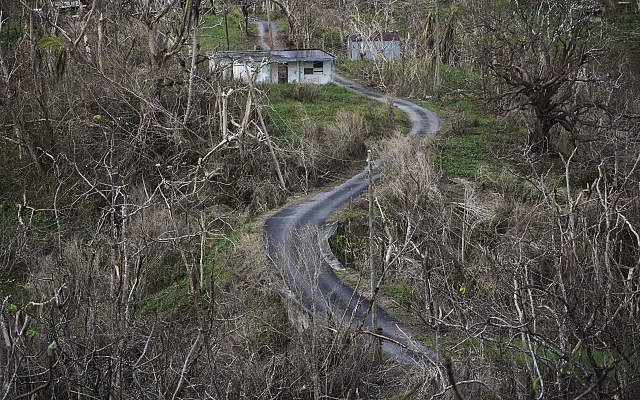Governor says 34 on island dead, hours after Trump says hurricane was ‘not a real catastrophe like Katrina’

The governor of Puerto Rico said Tuesday that the official death toll from Hurricane Maria has been increased to 34 from 16, as the White House said it would seek a $29 billion aid package to help the areas ransacked by a slew of hurricanes recover.
Announcing the new death toll shortly after US President Donald Trump toured the island, Governor Ricardo Rossello also said he believes the hurricane caused $90 billion in damage across the US territory.
During his stop, Trump congratulated Puerto Ricans for avoiding a high death toll of “a real catastrophe like Katrina.” As many as 1,800 people died in 2005 when Hurricane Katrina breached levees protecting New Orleans.
He later said his tour of storm damage in Puerto Rico was a “terrific visit” and the residents of the US island “are so thankful for what we’ve done.”
He told reporters aboard Air Force One that “we only heard thank-yous” during the visit, and said it was “an honor” to spend time in Puerto Rico amid its recovery from Hurricane Maria.
Trump had been criticized by local officials and others for failing to address urgent needs in Puerto Rico after Maria ripped across the island on September 20.
A senior administration official and top congressional aides later said the administration was finalizing a $29 billion disaster aid package that combines $16 billion to shore up the government-backed flood insurance program with almost $13 billion in new relief for hurricane victims.
The huge request is expected to be officially sent to Congress on Wednesday, but its outlines were characterized by officials who demanded anonymity because the $29 billion measure is not yet public.
The request would address two pressing needs. The first is to pump money into the flood insurance program, which is rapidly running out of cash to pay an influx of claims from victims of hurricanes Harvey, Irma, and Maria. At the same time, the Federal Emergency Management Agency continues to spend money for disaster relief operations at a high rate and requires more money.
The government-guaranteed flood insurance program is maxing out on a $30 billion line of credit from Treasury; the upcoming proposal would wipe $16 billion of that debt off the books to permit the program to pay claims from hurricane victims.

Almost $13 billion is being requested for FEMA, and federal firefighting accounts would receive $577 million as well to replenish them after a disastrous season of Western wildfires.
“This is going to be extraordinarily expensive and I think we need to get some money out there,” said House Appropriations Committee Chairman Rodney Frelinghuysen, R-N.J.
House Majority Leader Kevin McCarthy, R-Calif., said he had met with lawmakers from Texas and Florida on Tuesday to brief them on the White House request.
“Remember, this is emergency money. You’ve got to deal with the problem,” McCarthy told reporters. “So I think we’ll be able to get this done.”
The request could prove controversial, especially the huge infusion into the flood insurance program. Conservatives are likely to liken it to a taxpayer bailout, but the program is enormously important to homeowners in hurricane-ravaged Texas and Florida, as well as other coastal states.
Congress is in the midst of an effort to reauthorize the troubled flood insurance program, which critics say makes taxpayers subsidize properties that have repeatedly flooded. A bipartisan effort to reform the program was enacted in 2012 but was significantly watered down just two years later after widespread complaints of huge premium increases and resulting disruptions in coastal real estate markets.
Congress last month approved a $15.3 billion aid package that nearly doubled President Donald Trump’s request. Senate Republicans added $7.4 billion in community development block grant rebuilding funds to Trump’s request for immediate cleanup, repair and housing costs.
Later this year, the White House is expected to require tens of billions of dollars more in long-term funds that would rebuild infrastructure, help people without insurance restore their homes, and, perhaps, help Puerto Rico reconstitute its shattered electrical grid.

During his tour of hurricane damage in Puerto Rico on Tuesday, Trump praised his administration’s response, even as lawmakers returning from the island say the president is painting far too rosy a picture.
“What you’re seeing is a mirage,” Rep. Luis Gutierrez, D-Ill., said of conditions in San Juan, where Trump visited and where many reporters are located. Many mountain towns are cut off, with sick and elderly people trapped. “I saw the video on TV and everybody’s friendly and everybody’s smiling. You know what? It gave the wrong impression of what’s going on in the island.”
As reported by The Times of Israel
